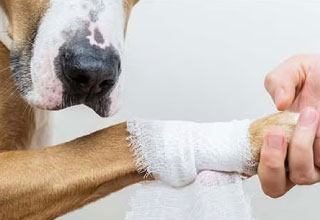- text
-
Everyday Pet Insurance policies entered into for the first time prior to 17 July 2023 and subsequent renewals of those policies are issued by The Hollard Insurance Company Pty Ltd ABN 78 090 584 473, AFSL 241436 (Hollard), arranged and administered by PetSure (Australia) Pty Ltd ABN 95 075 949 923, AFSL 420183 (PetSure) and promoted and distributed by Hollard’s Authorised Representative (AR) Woolworths Group Limited ABN 88 000 014 675, AR 245476 (Woolworths). Everyday Pet Insurance policies entered into for the first time on or after 17 July 2023 and subsequent renewals of those policies are issued by PetSure and promoted and distributed by PetSure’s AR, Woolworths. Any advice provided is general only and does not take into account your individual objectives, financial situation or needs. Please consider the Product Disclosure Statement (PDS) to ensure this product meets your needs before purchasing, or choosing to continue with the product. PDS and Target Market Determination available at insurance.everyday.com.au/pet-insurance.
Pre-existing conditions update.
To help pet parents get the most from their pet insurance policies, we’ve recently made some changes to how pre-existing conditions are handled for all Everyday pet insurance policies. This applies to claims with a veterinary treatment date from 1 December 2020.
What is a pre-existing condition?
A pre-existing condition is a condition that first existed or occurred:
prior to the commencement date of your first policy period; or
within any applicable waiting period;
AND
is a condition that you were aware of, or a reasonable person in your circumstances would have been aware of, irrespective of whether the underlying or causative condition has been diagnosed.
A pre-existing condition also includes a related condition or bilateral condition of a pre-existing condition.
What’s changed?
Not all pre-existing conditions are created equal. To help pet parents claim for more eligible conditions, from 1 December 2020, pre-existing conditions are now assessed depending on whether they are considered a temporary or a chronic condition.
Vets are not able to prescribe medication or provide you with any information about your insurance policy. Any consultations with VetAssist does not guarantee an approved claim.
Temporary pre-existing condition.
A temporary pre-existing condition is a pet health condition that usually resolves with treatment and is automatically removed as an exclusion from your policy if your pet hasn’t shown signs of that condition for 18 months or more prior to your claim treatment date. This will apply to claims for temporary conditions with a treatment date occurring on or after 1 December 2020.
Chronic pre-existing condition.
A chronic pre-existing condition is a pet health condition that requires ongoing care or is more prolonged in nature, and affects your pet over a period that is greater than three months in total (the three-month period need not be consecutive). So if your pet displays one of these conditions prior to the purchase of a pet insurance policy or its waiting period, it will never be coverable under the policy.
Some of these conditions include:
- Cruciate ligament conditions
- Intervertebral disc disease
- Hip dysplasia
- Elbow dysplasia
- Patella luxation
- Endocrine diseases
- Any other chronic condition
An important reminder that these exclusions only relate to pre-existing conditions. If your pet requires treatment after the purchase of a pet insurance policy and its waiting period, all conditions outlined in the policy’s Product Disclosure Statement will be eligible for cover for the life of the policy subject to the terms and conditions of your cover.
How do I know if it's a temporary or chronic pre-existing condition?
Let’s take a quick look at some examples to help differentiate the difference between a temporary pre-existing condition (which can be removed as an exclusion after the 18 month asymptomatic period), and a chronic pre-existing condition (which will always be excluded if pre-existing).
Note: The examples above are of a general nature and you should refer to the Product Disclosure Statement and Certificate of Insurance for information about conditions covered under your specific level of cover.
Want a pre-existing condition reviewed on your policy?
All temporary pre-existing conditions are automatically removed from your pet insurance policy as an exclusion if your pet hasn’t shown signs or symptoms of that condition for 18 months or more, so there’s nothing more for you to do.
A chronic pre-existing condition is a pet health condition that requires ongoing care or is more prolonged in nature, so if your pet displays one of these conditions prior to the purchase of a pet insurance policy or its’ waiting period, it will never be coverable under the policy.
If you would still like to have a pre-existing condition on your pet insurance policy reviewed, you can do so anytime. Simply complete the pre-existing condition policy review form with your Vet and we will provide an outcome.




